Athlone, Co. Westmeath
Athlone Poor Law Union was formed on 8th April 1839 and covered an area of 311 square miles. Its operation was overseen by an elected Board of Guardians, 27 in number, representing its 19 electoral divisions as listed below (figures in brackets indicate numbers of Guardians if more than one):
Co. Westmeath:
Ballyloughloe, Ballymore, Bunown, Drumreaney, Kilcleagh, Kilcumreach, Kilkenny West, Moate (2), Noughaval, St Mary's (3).
Co. Roscommon:
Athlone (5), Cam, Dysart, Kiltoom (2), Rahara, St John's, Taghboy, Taghmaconnell, Tisrara.
The Board also included 9 ex-officio Guardians, making a total of 36. The Guardians met each week on Saturday.
The population falling within the Union at the 1831 census had been 73,052 with divisions ranging in size from Rahara (population 1,630) to Athlone itself (12,274).
The new workhouse, built in 1839-41, occupied a 7-acre site to the east of the River Shannon. It was designed to accommodate 900 inmates and its construction cost £7,500 plus £1,801 for fixtures and fittings etc. It was declared fit for the admission of paupers on 20th October 1841 and admitted its first inmates a month later on 22nd November. The site location and layout are shown on the 1914 OS map below.
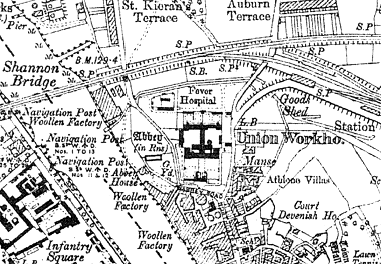
Athlone workhouse site, 1914.
The workhouse building followed one of the standard designs by the Poor Law Commission's architect George Wilkinson. A two-storey entrance block at the south of the site fronted onto Abbey Road.
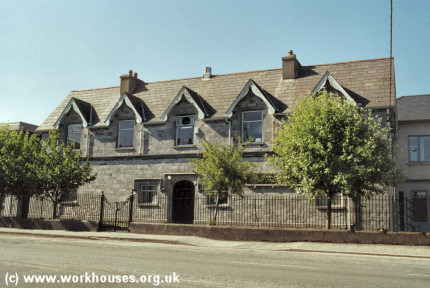
Athlone workhouse entrance block from the south, 2000.
© Peter Higginbotham.
Behind this stood a three-storey accommodation block, one half of which accommodated males, the other half females.
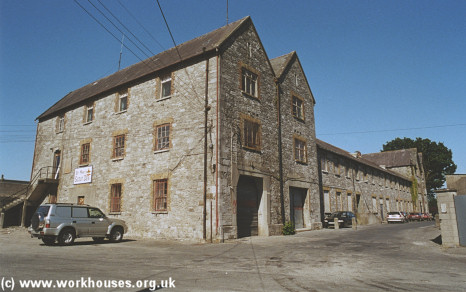
Athlone accommodation block from the south-west, 2000.
© Peter Higginbotham.
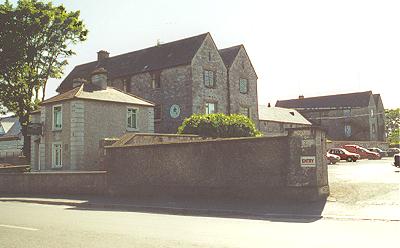
Athlone accommodation block from the north-east, 2000.
© Peter Higginbotham.
At the rear, a range of single-storey utility rooms such as bakehouse and washhouse connected through to the infirmary and idiots' wards via a central spine containing the chapel and dining-hall. A small mortuary block survives at the west of the site.
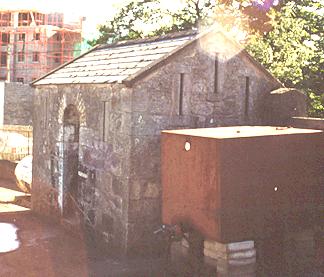
Athlone mortuary block from the north, 2000.
© Peter Higginbotham.
In common with other unions in Ireland, Athlone suffered greatly during the famine years 1845-50. The workhouse was greatly overcrowded, food was short, sanitation was poor, and diseases such as typhus fever and dysentery were widespread. O'Connor (1995) quotes a letter entitled 'Distress in Ireland' by Joseph Crosfield which described conditions workhouse conditions in December 1846:
A fever hospital was erected at the north of the workhouse site. In the second half of the nineteenth century, the hospital facilities gradually expanded with the creation of what became St Vincent's Hospital. In 1890, two nuns from the Sisters of Mercy joined the nursing staff at the workhouse hospital. By 1915, the majority of the workhouse's 200 inmates were actually hospital patients.
In 1895, Athlone was visited by a "commission" from the British Medical Journal investigating conditions in Irish workhouse infirmaries. Their report noted that the employment of nuns as nurses appeared to have resulted in improvements in the treatment of the sick. This was despite the sisters having no formal medical training, only working during the day, and not directly nursing male or maternity patients. The commission also observed a great many defexts at the workhouse, especially the miserable conditions in the aged and lunatic wards, and in the children's nursery. Further details are available in the full report. The subsequent appointment of an untrained nun as a night-time nurse, contrary to Local Government Board regulations, led to the Athlone Board of Guardians being dissolved.
At the 1901 census, the population of the Union was 27,264.
In August 1921, as part of the Westmeath workhouse amalgamation scheme, the county's three Boards of Guardians were abolished. Athlone was subsequently redesignated as a District Hospital with its former inmates being transferred to the former Mullingar workhouse, which became a County Home and run by a management committee.
In more recent times, the original entrance block of the workhouse was used by a local college. The main accommodation block has been used by the local Fire Service and various small businesses etc.
Inmates
Staff
In 1905, workhouse staff were as follows:
- Master - Michael Donnelly
- Matron - Mary M Casserley
- Chaplains - Very Rev. Richard SD Campbell (COI), Rev. Charles O'Farrell (RC)
- Medical Officer - Michael Shanley
Records
Note: many repositories impose a closure period of up to 100 years for records identifying individuals. Before travelling a long distance, always check that the records you want to consult will be available.
- Westmeath County Library HQ, Dublin Road, Mullingar. Many records have restricted access. Please contact the Archives department before visiting to discuss your query. Holdings include: Guardians' minute books (4 October 1849 - 31 March 1922, with gaps); some later financial records.
Bibliography
- O'Brien, Brendan; edited by O'Brien, Gearoid (1995) Athlone Workhouse and the Famine (The Old Athlone Society)
- Crossman, V (2006) Politics, Pauperism and Power in Late Nineteenth-century Ireland
- Gray, P (2009) The Making of the Irish Poor Law, 1815-43
- O'Connor, J (1995) The Workhouses of Ireland
Links
- None.
Unless otherwise indicated, this page () is copyright Peter Higginbotham. Contents may not be reproduced without permission.


